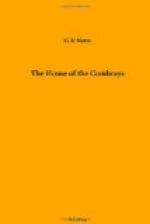Thus ends the story of the yellow horse. It finished its mysterious odyssey in the stables of Savoye-Rollin, where Licquet often visited it, as if he could thus learn its secret. For a doubt remained, and Real’s suggestion haunted him: “If the horse had only served for Mme. Acquet’s flight, they would not advise the strange precaution of taking it twelve leagues away, killing, and skinning it on the spot.” Even now a great deal of mystery hangs about it. The horse had not been used by Mme. Acquet, because we know that since the robbery of June 7th, she had not left the neighbourhood of Falaise. Lefebre had ridden it from Tournebut; but was that a fact to be so carefully concealed? Why did the Marquise in her confidential letters insist on this point? “Say that the lawyer returned to his house on foot,” is a sentence that we find in each of her letters. Since no mystery was made of the journey, why was its means of accomplishment important?
There was something unexplained, and Licquet was not satisfied. His tricks had brought no result. D’Ache was not found; Mme. Acquet had disappeared; her description had in vain been sent to all the brigades. Manginot, in despair of finding her, had renounced the search, and Savoye-Rollin himself was “determined to suspend all action.” Such was the situation during the last days of September. It seemed most probable that the affair of Quesnay and the great plot of which it was an off-shoot, were going to join many others of the same kind, whose originators Fouche’s police had despaired of finding, when an unexpected event reawakened Licquet’s fervour and suggested to him a new machination.
CHAPTER VII
MADAME ACQUET
Seclusion, isolation and trouble had in no way softened the Marquise de Combray’s harsh nature. From the very first day, this woman, accustomed to living in a chateau, had accommodated herself to the life of a prisoner without abating anything of her haughty and despotic character. Her very illusions remained intact. She imagined that from her cell she still directed her confederates and agents, whom she considered one and all as servants, never suspecting that the permission to write letters, of which she made such bad use, was only a trap set for her ingenuous vanity. In less than a month she had written more than a hundred letters to her fellow-prisoners, which all passed through Licquet’s hands. To one she dictated the answers he was to give, to another she counselled silence,—setting herself up to be an absolute judge of what they ought to say or to hold back, being quite unable to imagine that any of these unhappy people might prefer life to the pleasure of obeying her. She would have treated as a liar any one, be he who he might, who affirmed that all her accomplices had deserted her, that Soyer had hastened to disclose the secret hiding-places at Tournebut, that Mlle. Querey had told all about what she had seen, that Lanoe pestered Caffarelli with his incessant revelations, and that Lefebre, whom nothing but prudence kept silent, was very near telling all he knew to save his own head.




